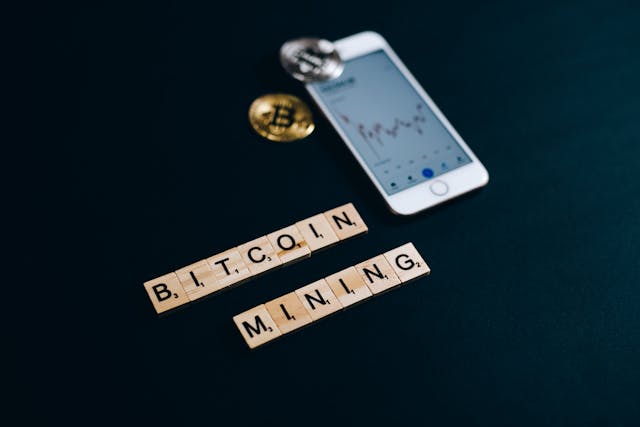Introduction
Crypto mining is the backbone of the decentralized digital currency system. It is the process by which new cryptocurrencies, such as Bitcoin and Ethereum, are generated, verified, and added to the blockchain. For many, mining is also a way to earn passive income. But how does it work, and what do you need to start mining yourself?
In this guide, we’ll walk you through everything you need to know about mining: what it is, how it works, the different types of mining, and how you can start mining yourself. Whether you’re just curious or looking to become a miner, we’ve got you covered.
How Bitcoin Mining Works
The Proof-of-Work System
Bitcoin and many other cryptocurrencies use the Proof-of-Work (PoW) mechanism to secure their networks. In simple terms, miners use powerful computers to solve complex mathematical problems (also known as cryptographic puzzles). The first miner to solve the puzzle gets rewarded with freshly minted Bitcoin.
This process ensures the integrity and security of the network. Each time a miner successfully completes a puzzle, they confirm a new block of transactions on the blockchain.
The Role of Miners in the Network
Miners perform a crucial role in maintaining the decentralized nature of Bitcoin. They verify transactions, ensure the network’s security, and create new blocks on the blockchain. Without miners, the entire system wouldn’t function as efficiently.
Types of Crypto Mining
Proof of Work (PoW)
Proof of Work is the most traditional and widely used consensus algorithm in crypto mining. It requires miners to solve computationally intensive puzzles to validate transactions and create new blocks. Bitcoin, Ethereum (before its switch to PoS), and many others use PoW.
Proof of Stake (PoS)
Unlike PoW, Proof of Stake doesn’t require miners to perform complex calculations. Instead, participants “stake” a portion of their coins, and the network selects validators based on the amount of cryptocurrency they hold and are willing to lock in as collateral.
Hybrid Models
Some cryptocurrencies, like Decred and Horizen, use a hybrid of both PoW and PoS to balance the benefits of both systems. This provides greater network security and more efficient block production.
What Do You Need to Start Mining?
Mining Hardware
The most essential component of mining is the hardware. There are three primary types of mining hardware:
-
ASICs (Application-Specific Integrated Circuits): These are custom-built machines designed for a single purpose: mining a specific cryptocurrency, most commonly Bitcoin. ASIC miners are extremely powerful and efficient but also expensive.
-
GPUs (Graphics Processing Units): These are standard graphics cards used in gaming computers. GPUs are versatile and can mine various coins, making them ideal for altcoins like Ethereum.
-
CPUs (Central Processing Units): This is the least effective hardware for mining and is only suitable for certain low-difficulty coins.
Mining Software
Mining software is essential for interacting with your hardware and the blockchain. Popular mining software includes:
-
CGMiner for ASICs
-
Claymore for Ethereum (GPU mining)
-
NiceHash for easy mining setup
Energy and Internet Requirements
Mining consumes a lot of energy, so a stable power supply is crucial. Make sure you have reliable electricity to run your rig 24/7. Additionally, a stable internet connection is necessary for your mining hardware to communicate with the blockchain and other miners.
Understanding Mining Pools
What Is a Mining Pool?
A mining pool is a group of miners who combine their computational power to solve blocks faster. When a block is mined, the rewards are shared among all pool members based on the amount of computational work they contributed.
The Benefits and Drawbacks of Mining Pools
-
Benefits: Mining pools increase the chances of earning regular payouts. Since the rewards are shared, miners get paid more consistently than if they were mining solo.
-
Drawbacks: Mining pools usually charge a fee, and you have to trust the pool operator. Additionally, the rewards are divided among all participants, meaning your individual payout is smaller.
Is Crypto Mining Profitable?
Factors That Affect Profitability
Several factors can affect the profitability of crypto mining:
-
Hashrate: The computational power of your hardware.
-
Electricity Costs: Mining is energy-intensive, so low electricity costs are essential for profitability.
-
Difficulty Level: As more miners join the network, the difficulty of mining increases, reducing the chances of successfully mining a block.
-
Coin Value: The value of the cryptocurrency you mine plays a major role in your overall earnings.
ROI (Return on Investment) in Mining
Mining can be profitable if you have the right setup and a low-cost electricity source. However, the initial investment in hardware and the ongoing operational costs mean that miners often have to wait several months or even years before seeing a positive return on investment (ROI).
Environmental Impact of Crypto Mining
The Debate Around Energy Consumption
Crypto mining has often been criticized for its high energy consumption, particularly Proof-of-Work mining. For example, Bitcoin’s network consumes more electricity than some countries! Critics argue that this contributes to carbon emissions and environmental damage.
Green Mining Solutions
Several initiatives aim to reduce the environmental impact of crypto mining. Some miners are now using renewable energy sources, such as solar and wind power, to power their rigs. Additionally, newer cryptocurrencies are adopting Proof-of-Stake (PoS) and other eco-friendly consensus algorithms to reduce energy consumption.
How to Choose a Crypto Mining Setup
ASIC vs GPU Mining
When deciding between ASICs and GPUs, consider the following:
-
ASICs: Great for mining specific coins like Bitcoin. Highly efficient but costly.
-
GPUs: More versatile and cheaper but not as powerful as ASICs. Ideal for altcoins.
Choosing the Right Cryptocurrency to Mine
Not all cryptocurrencies are worth mining. Some are too competitive or have too high a difficulty level, making them unprofitable. Always choose a coin with low difficulty but promising long-term potential.
Risks and Challenges in Crypto Mining
The Risk of Mining Rig Failures
Mining hardware is complex, and it’s not uncommon for rigs to fail due to overheating, power surges, or mechanical issues. To avoid downtime, regular maintenance is required.
Regulatory and Legal Issues
Crypto mining faces legal challenges in several countries, where it is either heavily regulated or outright banned. Stay informed about the legal status of mining in your region to avoid unnecessary complications.
How to Keep Your Mining Profits Secure
Wallets for Miners
To store your mining rewards securely, use a crypto wallet. Hardware wallets (such as Ledger and Trezor) are the most secure option for storing large amounts of cryptocurrency.
Best Practices for Security
-
Enable two-factor authentication (2FA) on your accounts.
-
Use cold wallets for long-term storage.
-
Keep your private keys safe and never share them with anyone.
Conclusion
Crypto mining is an exciting and potentially profitable activity that plays a key role in the cryptocurrency ecosystem. While it comes with challenges such as high energy consumption, hardware costs, and market volatility, it also offers the opportunity to be a part of a decentralized financial revolution.
By understanding the essentials of mining, choosing the right setup, and staying informed about market trends, you can take the first step toward becoming a successful miner.
FAQs
1. Can I mine Bitcoin on my computer?
While it’s technically possible, it’s not profitable. Bitcoin mining requires specialized ASIC miners that are much more efficient than regular computers.
2. What is the most profitable coin to mine in 2025?
The most profitable coin to mine will depend on factors like hardware, electricity costs, and market trends. Ethereum (before its switch to PoS) and Ravencoin are often mentioned as good options.
3. How much electricity does crypto mining use?
Crypto mining, especially Bitcoin, can consume significant electricity, with some estimates saying that Bitcoin mining consumes more energy than entire countries. The consumption depends on your mining setup.
4. How do I join a mining pool?
To join a mining pool, create an account on a pool platform like F2Pool, Slush Pool, or Poolin. After that, configure your mining software to point to the pool’s server.
5. Are there any tax implications for crypto miners?
Yes, crypto mining is taxable in many countries. Any rewards earned from mining are considered taxable income. Keep detailed records of your mining activities to ensure accurate tax reporting.
Please don’t forget to leave a review.


